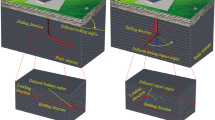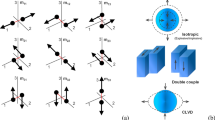Abstract
Radial jet drilling technology (RJD) is an economical and efficient technology for the development of unconventional oil, gas, and geothermal resources. The self-rotated multi-orifice nozzle, which is the key for the hole-forming, is introduced and tested here. Its sandstone-breaking characteristics are researched by experiment, the influence of working conditions, lithology, axis length, jet pressure (15 ~ 40 MPa), and standoff distance (0 ~ 10 mm) is also studied. Moreover, optimal working parameters for continuous drilling are proposed. Results show that the self-rotating multi-orifice nozzle can effectively drill a large circular hole whose diameter is about 30 mm under the condition of fixed standoff distance or continuous feeding. The submergence conditions are helpful to improve rock breaking efficiency. The short-axis nozzle has good hydraulic performance and rock breaking ability. Uniaxial compressive strength affects rock breaking diameter, while permeability affects rock breaking depth and volume. The rock breaking diameter, depth and volume of sandstone both increase with the jet pressure. The rock breaking diameter increases with the standoff distance, while the rock breaking volume and depth are opposite. The diameter of the rock breaking hole decreased with the augment of the feeding speed. For the sandstone here, the jet pressure is recommended as 35 MPa and the feeding speed 0.03 m/min (1.8 m/h); laterals with a diameter of about 30 mm can be formed. The research results are expected to promote the development of RJD technology.














Similar content being viewed by others
Data Availability
Data will be available from the author on request.
Code Availability
Not applicable.
References
Abdel-Ghany MA, Siso S, Hassan AM, et al. (2011) New technology application, radial drilling petrobel, first well in Egypt. The Offshore Mediterranean Conference, Ravenna, Italy.
Ashena R, Mehrara R, Ghalambor A (2020) Well productivity improvement using radial jet drilling. In proceedings of the SPE international conference and exhibition on formation damage control, Lafayette, LA, USA, Society of petroleum engineers (SPE): London, UK.
Bi G, Li M, Dou L, Qu Z, Zhao K (2018) Optimization design and rock-breaking characteristics analysis of a self-propelled swirling multi-jet bit. Energy Sci Eng 6(6):716–726
Bruni MA, Biasotti JH, Salomone GD (2007) Radial drilling in Argentina[R]. SPE107382.
Buset P, Riiber M, Eek A (2001) Jet drilling tool: cost-effective lateral drilling technology for enhanced oil recovery. SPE/ICoTA coiled tubing roundtable, Houston, TX, SPE Paper No.SPE-68504-MS.
Chen HD, Cheng YP, Zhou HX (2013) Damage and permeability development in coal during unloading. Rock Mech Rock Eng 46(6):1377–1390. https://doi.org/10.1007/s00603-013-0370-2
Chi H, Li G, Liao H, Tian S, Song X (2016) Effects of parameters of self-propelled multi-orifice nozzle on drilling capability of water jet drilling technology. Int J Rock Mech Min 86:23–28
Cinelli SD, Kamel AH (2013) Novel technique to drill horizontal laterals revitalizes aging field[R]. SPE163405.
Cirigliano RA, Blacutt JFT (2007) First experience in the application of radial perforation technology in deep wells [R]. SPE107182.
Dickinson W, Dickinson RW (1985) Horizontal radial drilling system. The SPE California regional meeting, Conf, Bakersfield, California.
Dickinson W, Anderson RR, Dickinson RW (1989) The ultrashort-radius radial system. SPE Drill Eng 4(03):247–254. https://doi.org/10.2118/14804-PA
Dickinson W, Dykstra H, Nees J M, et al. (1992) The ultrashort radius radial system applied to thermal recovery of heavy oil [R]. SPE24087.
Dong CY, Li YL, Long JJ et al (2014) Operation optimization of plugged screen cleanup by rotary water jetting. Petrol Sci 11:122–130
Fallahzadeh SH, Rasouli V, Sarmadivaleh M (2015) An investigation of hydraulic fracturing initiation and near-wellbore propagation from perforated boreholes in tight formations. Rock Mech Rock Eng 48(2):573–584. https://doi.org/10.1007/s00603-014-0595-8
Fu P, Hao Y, Walsh SDC, Carrigan CR (2015) Thermal drawdown-induced flow channelling in fractured geothermal reservoirs. Rock Mech Rock Eng 49(3):1001–1024
Fu B, Zhang S, Liu S, Zhu Z (2021) Drilling performance analysis of a new type of direct-rotating mixed-jet nozzle. J Petroleum Sci Eng 200(3):108302
Ge ZL, Deng K, Zhou Z et al (2020) Fracture characteristics of coal jointly impacted by multiple jets. Eng Fract Mech 235:107171. https://doi.org/10.1016/j.engfracmech.2020.107171
Kamel AH (2016) RJD: a cost effective frackless solution for production enhancement in marginal fields [R]. SPE184053.
Kamel AH (2017) Radial jet drilling: a technical review SPE middle east oil & gas show and conference. Soc Petrol Eng. https://doi.org/10.2118/183740-MS
Li GS, Huang ZW, Tian SC et al (2010) Research and application of water jet technology in well completion and stimulation in China. Petrol Sci 7(2):239–244
Li MJ, Wan TG, Shi SB, Zhu L, Fang RH (2014) Oil maturity assessment using maturity indicators based on methylated dibenzothiophenes. Petrol Sci 11(2):234–246. https://doi.org/10.1007/s12182-014-0336-3
Li J, Li G, Huang Z, Song X, Yang R, Peng K (2015) The self-propelled force model of a multi-orifice nozzle for radial jet drilling. J Nat Gas Sci Eng 24:P441-448. https://doi.org/10.1016/j.jngse.2015.04.009
Li J, Li G, Huang Z et al (2017) A discussion about the method to study the effect of bottom pressure on hydraulic jetting. J Petrol Sci Eng 149:203–207. https://doi.org/10.1016/j.petrol.2016.10.043
Li J, Huang Z, Zhang G, Liu X, Li H (2020) Rock breaking characteristics of the self-rotating multi-orifices nozzle applied to coalbed methane radial jet drilling. Int J Rock Mech Min 136:104483
Liao HL, Wu DS, Wang L et al (2013) Comparisons of spraying structure and rock breakage characteristics of round straight, swirling, and straight-swirling integrated jets. Atomizat Spray 23(4):363–377
Liao H, Jia X, Niu J et al (2020) Flow structure and rock-breaking feature of the self-rotating nozzle for radial jet drilling[J]. Petrol Sci 17(1):211–221
Liu Y, Ba Q, He L et al (2020) Study on the rock-breaking effect of water jets generated by self-rotatory multinozzle drilling bit. Energy Sci Eng 6:2457–2462. https://doi.org/10.1002/ese3.679
Lu Y, Xiao S, Ge Z et al (2019) Experimental study on rock-breaking performance of water jets generated by self-rotatory bit and rock failure mechanism[J]. Powder Technol 346:203–216
Marbun B, Putra S. (2011) Review of ultrashort-radius radial system(URRS). Proceedings of the international petroleum technology conference. Bangkok.
Maut PP, Jain D, Mohan R et al (2017) Production enhancement in mature fields of Assam Arakan basin by radial jet drilling-a case study. In SPE symposium: production enhancement and cost optimisation. Soc Petrol Eng. https://doi.org/10.2118/189243-MS
Medetbekova M, Salimzadeh S, Christensen H, et al. (2018) Experimental and numerical study of the stability of radially jet drilled laterals in chalk reservoirs. 80th EAGE Conference and Exhibition 2018.
Nair R, Peters E, Sliaupa S, Valickas R, Petrauskas S. (2013) A case study of radial jetting technology for enhancing geothermal energy systems at klaip_eda geothermal demonstration plant. 42nd workshop on geothermal reservoir engineering Stanford University, Stanford, CA, Feb. 13–15, 2017, Paper No. SGP-TR-212.
Peters E, Blöcher G, Salimzadeh S, Egberts PJP, Cacace M (2018) Modelling of multi-lateral well geometries for geothermal applications. Adv Geosci 45:209–215
Reinsch T, Bruhn D. The SURE consortium. (2016) Novel productivity enhancement concept for a sustainable utilization of a geothermal resource e the SURE project. In: Proceedings, European geothermal Congress 2016, Strasbourg; p. 4.
Reinsch T, Paap B, Hahn S, Wittig V, Berg SVD (2018) Insights into the radial water jet drilling technology - application in a quarry. J Rock Mech Rock Eng 10(02):236–248. https://doi.org/10.1016/j.jrmge.2018.02.001
Rui ZH, Cui KH, Wang XQ et al (2018) A quantitative framework for evaluating unconventional well development. J Petrol Sci Eng 166:900–905. https://doi.org/10.1016/j.petrol.2018.03.090
Salimzadeh S, Grandahl M, Medetbekova M, Nick HM (2019) A novel radial jet drilling stimulation technique for enhancing heat recovery from fractured geothermal reservoirs. Renew Energ 139:395–409
Shen Z, Sun Q (1988) Study of pressure attenuation of a submerged, nonfree jet and a method of calculation for bottomhole hydraulic parameters. SPE Dril Eng 3(01):69–76. https://doi.org/10.2118/14869-PA (SPE-14869-PA)
Shi Y, Song X, Wang G, Li J, Geng L, Li X (2019) Numerical study on heat extraction performance of a multilateral-well enhanced geothermal system considering complex hydraulic and natural fractures. Renew Energ 141:950–963
Stoxreiter T, Martin A, Teza D, Galler R (2018) Hard rock cutting with high pressure jets in various ambient pressure regimes. Int J Rock Mech Min Sci 108:179–188
Ursegov S, Bazylev A, Taraskin E. (2008) First results of cyclic steam stimulations of vertical wells with radial horizontal bores in heavy oil carbonates (Russian) [R]. (SPE115125).
Wright DE (2009) Self regulating fluid bearing high pressure rotary nozzle with balanced thrust force[P]. (US8016210)
Wu X, Huang Z, Zhang S et al (2019) Damage analysis of high-temperature rocks subjected to LN2 thermal shock. Rock Mech Rock Eng 52:2585–2603. https://doi.org/10.1007/s00603-018-1711-y
Yonghe Li, Chunjie W, Lianhai S et al (2000) Application and development of drilling and completion of the ultrashort-radius radial well by high pressure jet flow techniques. SPE 64756:2000
Zang A, Zimmermann G, Hofmann H, Stephansson O, Min KB, Kim KY (2019) How to reduce fluid-injection-induced seismicity. Rock Mech Rock Eng 52(2):475–493. https://doi.org/10.1007/s00603-018-1467-4
Acknowledgements
This support is gratefully acknowledged by the authors, who are also grateful to the reviewers of this paper for their detailed comments.
Funding
This study was funded by National Key Scientific Research Instrument Research Project of NSFC (No. 51827804), Major Program of the National Natural Science Foundation of China (No. 51991362), and Science Foundation of China University of Petroleum, Beijing (No. 2462021YJRC009).
Author information
Authors and Affiliations
Contributions
LJ: conceptualization, formal analysis, and original draft. DJ: investigation and data curation. HZ: validation, review and editing. ZG: methodology and supervision. LX: resources. LH: visualization.
Corresponding author
Ethics declarations
Conflict of interest
The authors declare that they have no known competing financial interests or personal relationships that could have appeared to influence the work reported in this paper.
Additional information
Publisher's Note
Springer Nature remains neutral with regard to jurisdictional claims in published maps and institutional affiliations.
Rights and permissions
About this article
Cite this article
Li, J., Dai, ., Huang, . et al. Rock Breaking Characteristics of the Self-rotating Multi-orifice Nozzle for Sandstone Radial Jet Drilling. Rock Mech Rock Eng 54, 5603–5615 (2021). https://doi.org/10.1007/s00603-021-02567-z
Received:
Accepted:
Published:
Issue Date:
DOI: https://doi.org/10.1007/s00603-021-02567-z




